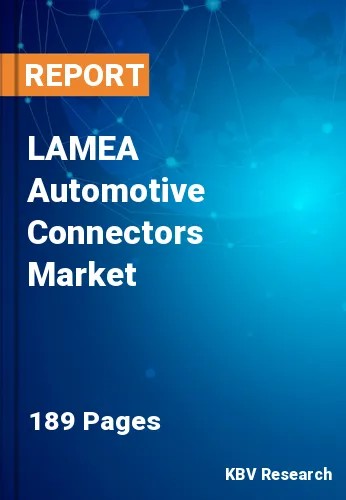The Latin America, Middle East and Africa Automotive Connectors Market would witness market growth of 7.1% CAGR during the forecast period (2023-2030).In the year 2026, the LAMEA market's volume is expected to surge to 94.9 million units, showcasing a growth of 9.2% (2023-2030).
From power distribution to the operation of GPS navigation-based features, connectors play a vital role in efficiently operating a vehicle's many electronic devices. Any connector malfunction could result in severe functional failure. Therefore, manufacturers concentrate predominantly on research and development initiatives to produce high-quality connectors with uninterrupted functioning.
Increased consumer safety concerns and government initiatives have increased the requirement for dependable connectors in various vehicle systems. For example, vehicle safety systems such as seatbelts, airbags, and brakes require a connection system consisting of a retainer and a safety restraint system connector. Consequently, the rising demand for automotive safety systems has a direct impact on the demand for automotive connectors, which in turn propels the market's expansion.
The main factors influencing market expansion are the increased demand for EVs and the increasing adoption of sophisticated security features in automobiles. To improve data transfer, increase design flexibility, and decrease overall vehicle weight, plastic optical fiber (POF) is replacing copper cables in automobiles. To function correctly, POF requires automotive connectors.
According to the International Council on Clean Transportation (ICCT), in 2020, new car sales in Latin American nations accounted for 7% of all global sales. Sub-Saharan African (SSA) nations urgently need alternative energy sources for transportation to mitigate the expanding burden of fuel dependence and subsidies and an electricity storage solution to maximize their abundant renewable energy resources. Due to this, many SSA nations are anticipated to make substantial investments in EV power capacity over the next decade. Increasing EV sales in the region would contribute to expanding the regional market.
The Brazil market dominated the LAMEA Automotive Connectors Market by Country in 2022, and would continue to be a dominant market till 2030; thereby, achieving a market value of $284.3 million by 2030. The Argentina market is estimated to grow at a CAGR of 7.6% during (2023 - 2030). Additionally, The UAE market would exhibit a CAGR of 6.8% during (2023 - 2030).
Based on Application, the market is segmented into Safety & Security, Powertrain, Comfort, Convenience, & Entertainment (CCE), Body Wiring & Power Distribution and Navigation & Instrumentation. Based on Product, the market is segmented into PCB, IC, RF, Fiber Optic, and Others. Based on Connectivity, the market is segmented into Wire to Wire, Wire to Board and Others. Based on Vehicle Type, the market is segmented into Commercial Vehicles, and Passenger Cars. Based on countries, the market is segmented into Brazil, Argentina, UAE, Saudi Arabia, South Africa, Nigeria, and Rest of LAMEA.
Free Valuable Insights: The Worldwide Automotive Connectors Market is Projected to reach USD 15.2 Billion by 2030, at a CAGR of 5.4%
The market research report covers the analysis of key stake holders of the market. Key companies profiled in the report include TE Connectivity Ltd., Yazaki Corporation, Aptiv PLC, Sumitomo Electric Industries, Ltd., Molex, LLC (Koch Industries, Inc.), Amphenol Corporation, Korea Electric Terminal Co., Ltd., Kyocera Corporation, Rosenberger Hochfrequenztechnik GmbH, and Japan Aviation Electronics Industry, Ltd.
By Application (Volume, Million Units, USD Million, 2019-2030)
By Product (Volume, Million Units, USD Million, 2019-2030)
By Connectivity (Volume, Million Units, USD Million, 2019-2030)
By Vehicle Type (Volume, Million Units, USD Million, 2019-2030)
By Country (Volume, Million Units, USD Million, 2019-2030)
Our team of dedicated experts can provide you with attractive expansion opportunities for your business.

